初一下册英语语法大全
- 格式:docx
- 大小:24.33 KB
- 文档页数:7
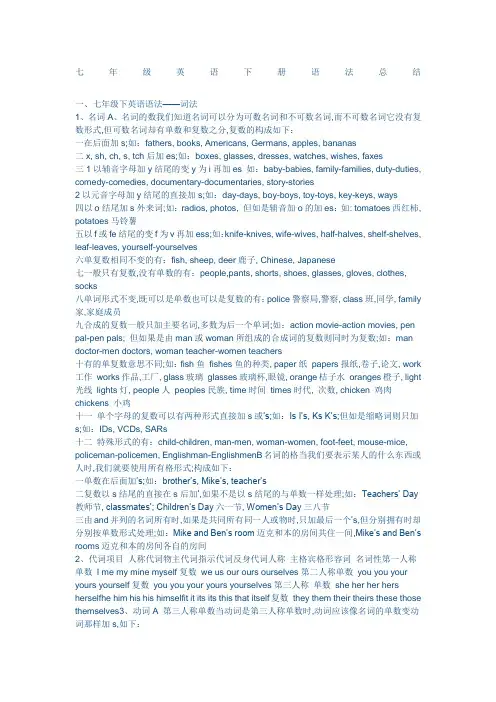
七年级英语下册语法总结一、七年级下英语语法——词法1、名词A、名词的数我们知道名词可以分为可数名词和不可数名词,而不可数名词它没有复数形式,但可数名词却有单数和复数之分,复数的构成如下:一在后面加s;如:fathers, books, Americans, Germans, apples, bananas二x, sh, ch, s, tch后加es;如:boxes, glasses, dresses, watches, wishes, faxes三1以辅音字母加y结尾的变y为i再加es 如:baby-babies, family-families, duty-duties, comedy-comedies, documentary-documentaries, story-stories2以元音字母加y结尾的直接加s;如:day-days, boy-boys, toy-toys, key-keys, ways四以o结尾加s外来词;如:radios, photos, 但如是辅音加o的加es:如: tomatoes西红柿, potatoes马铃薯五以f或fe结尾的变f为v再加ess;如:knife-knives, wife-wives, half-halves, shelf-shelves, leaf-leaves, yourself-yourselves六单复数相同不变的有:fish, sheep, deer鹿子, Chinese, Japanese七一般只有复数,没有单数的有:people,pants, shorts, shoes, glasses, gloves, clothes, socks八单词形式不变,既可以是单数也可以是复数的有:police警察局,警察, class班,同学, family 家,家庭成员九合成的复数一般只加主要名词,多数为后一个单词;如:action movie-action movies, pen pal-pen pals; 但如果是由man或woman所组成的合成词的复数则同时为复数;如:man doctor-men doctors, woman teacher-women teachers十有的单复数意思不同;如:fish鱼fishes鱼的种类, paper纸papers报纸,卷子,论文, work 工作works作品,工厂, glass玻璃glasses玻璃杯,眼镜, orange桔子水oranges橙子, light 光线lights灯, people人peoples民族, time时间times时代, 次数, chicken 鸡肉chickens 小鸡十一单个字母的复数可以有两种形式直接加s或’s;如:Is I’s, Ks K’s;但如是缩略词则只加s;如:IDs, VCDs, SARs十二特殊形式的有:child-children, man-men, woman-women, foot-feet, mouse-mice, policeman-policemen, Englishman-EnglishmenB名词的格当我们要表示某人的什么东西或人时,我们就要使用所有格形式;构成如下:一单数在后面加’s;如:brother’s, Mike’s, teacher’s二复数以s结尾的直接在s后加’,如果不是以s结尾的与单数一样处理;如:Teachers’ Day 教师节, classmates’; Children’s Day六一节, Women’s Day三八节三由and并列的名词所有时,如果是共同所有同一人或物时,只加最后一个’s,但分别拥有时却分别按单数形式处理;如:Mike and Ben’s room迈克和本的房间共住一间,Mike’s and Ben’s rooms迈克和本的房间各自的房间2、代词项目人称代词物主代词指示代词反身代词人称主格宾格形容词名词性第一人称单数I me my mine myself复数we us our ours ourselves第二人称单数you you your yours yourself复数you you your yours yourselves第三人称单数she her her hers herselfhe him his his himselfit it its its this that itself复数they them their theirs these those themselves3、动词A 第三人称单数当动词是第三人称单数时,动词应该像名词的单数变动词那样加s,如下:一一般在词后加s;如:comes, spells, waits, talks, sees, dances, trains二在x, sh, ch, s, tch后加es;如:watches, washes, wishes, finishes三1以辅音字母加y结尾的变y为i再加es;如:study-studies, hurry-hurries, try-tries2以元音字母加y结尾的直接加s;如:plays, says, stays, enjoys, buys四以o结尾加es;如:does, goes五特殊的有:are-is, have-hasB 现在分词当我们说某人正在做什么事时,动词要使用分词形式,不能用原形,构成如下:一一般在后加ing;如:spell-spelling, sing-singing, see-seeing, train-training, play-playing, hurry-hurrying, watch-watching, go-going, do-doing二以不发音e的结尾的去掉e再加ing;如:dance-dancing, wake-waking, take-taking, practice-practicing, write-writing, have-having三以重读闭音节结尾且一个元音字母+一个辅音字母注意除开字母组合如show –showing, draw-drawing要双写最后的辅音字母再加ing;如:put-putting, run-running, get-getting,let-letting, begin-beginning四以ie结尾的变ie为y再加ing;如:tie-tying系die-dying死lie-lying 位于4、形容词的级我们在对两个或以上的人或物进行对比时,则要使用比较或最高级形式;构成如下:一一般在词后加er或est如果是以e结尾则直接加r或st;如:greater-greatest, shorter –shortest, taller –tallest, longer –longest, nicer- nicest, larger –largest二以重读闭音节结尾且1个元音字母+1个辅音字母字母组合除外,如few-fewer fewest结尾的双写结尾的辅音再加er /est;如:big-bigger biggest, red-redder reddest, hot-hotter hottest三以辅音字母+y结尾的变y为i加er/est;如:happy-happier happiest, sorry-sorrier sorriest, friendly-friendlier friendliestmore friendly most friendly, busy-busier busiest, easy-easier easiest四特殊情况:两好多坏,一少老远good/well - better best many/much - more most bad/ill –worse worstlittle- less least old- older/elder oldest/eldest far- farther/furtherfarthest/furthest5、数词基变序,有规则;一、二、三,自己背;五、八、九、十二;其它后接th;y结尾,变为i, eth跟上去; first, second, third; fifth, eighth, ninth, twelfth; seventh, tenth, thirteenth, hundredth; twenty-twentieth, forty-fortieth, ninety-ninetieth二、七年级英语语法——句式1.陈述句肯定陈述句a This is a book. be动词b He looks very young. 连系动词c I want a sweat like this. 实义动词d I can bring some things to school. 情态动词e There’s a computer on my desk. There be结构否定陈述句a These aren’t their books. b They don’t look nice.c Kate doesn’t go to No. 4 Middle School. d Kate can’t find her doll.e There isn’t a cat here. =There’s no cat here.2. 祈使句肯定祈使句a Please go and ask the man. b Let’s learn Englishc Come in, please.否定祈使句a Don’t be late. b Don’t hurry.3. 疑问句1 一般疑问句a Is Jim a student b Can I help you c Does she like salad d Do they watch TV e Is she reading 肯定回答: a Yes, he is. b Yes, you can. c Yes, she does. d Yes, they do. e Yes, she is.否定回答: a No, he isn’t. b No, you can’t. c No, she doesn’t. d No, they don’t. e No, she isn’t.2 选择疑问句Is the table big or small 回答It’s big./ It’s small.3 特殊疑问句①问年龄How old is Lucy She is twelve.②问种类What kind of movies do you like I like action movies and comedies.③问身体状况How is your uncle He is well/fine.④问方式How do/can you spell it L-double O-K.How do we contact you My e-mail address is cindyjones163.⑤问原因Why do you want to join the club⑥问时间What’s the time =What time is it It’s a quarter to ten a.m..What time do you usually get up, Rick At five o’clock.When do you want to go Let’s go at 7:00.⑦问地方Where’s my backpack It’s under the table.⑧问颜色What color are they They are light blue.What’s your favourite color It’s black.⑨问人物Who’s that It’s my sister.Who is the boy in blue My brother.Who isn’t at school Peter and Emma.Who are Lisa and Tim talking to⑩问东西What’s this/that in English It’s a pencil case.What else can you see in the picture I can see some broccoli, strawberries and hamburgers.11问姓名What’s your aunt’s name Her name is Helen./She’s Helen.What’s your first name My first name’s Ben.What’s your family name My family name’s Smith.12 问哪一个Which do you like I like one in the box.13 问字母What letter is it It’s big D/small f.14 问价格How much are these pants They’re 15 dollars.15 问电话号码What’s your phone number It’s 576-8349.16 问谓语动作What’s he doing He’s watching TV.17 问职业身份What do you do I’m a teacher.What’s your father He’s a doctor.三、七年级英语语法——时态1、一般现在时表示普遍、经常性的或长期性的动作时使用一般现在时,它有:Be 动词:She’s a worker. Is she a worker She isn’t a worker.情态动词:I can play the piano. Can you play the piano I can’t play the piano.行为动词:They want to eat some tomatoes. Do they want to eat any tomatoes They don’t want to eat any tomatoes.Gina has a nice watch. Does Gina have a nice watch Gina doesn’t have a watch.2、现在进行时表示动词在此时正在发生或进行就使用进行时态,结构为sb be v-ing sth + 其它.I’m playing baseball. Are you playing baseball I’m not playing baseball.Nancy is writing a letter. Is Nancy writing a letter Nancy isn’t writing a letter.They’re listening to the pop music. Are they listening the pop music They aren’t listening to the pop music.。
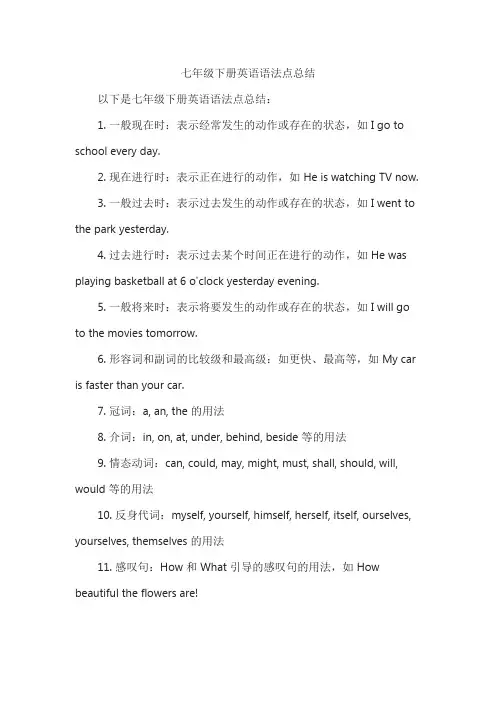
七年级下册英语语法点总结以下是七年级下册英语语法点总结:1. 一般现在时:表示经常发生的动作或存在的状态,如 I go to school every day.2. 现在进行时:表示正在进行的动作,如 He is watching TV now.3. 一般过去时:表示过去发生的动作或存在的状态,如 I went to the park yesterday.4. 过去进行时:表示过去某个时间正在进行的动作,如 He was playing basketball at 6 o'clock yesterday evening.5. 一般将来时:表示将要发生的动作或存在的状态,如 I will go to the movies tomorrow.6. 形容词和副词的比较级和最高级:如更快、最高等,如 My car is faster than your car.7. 冠词:a, an, the 的用法8. 介词:in, on, at, under, behind, beside 等的用法9. 情态动词:can, could, may, might, must, shall, should, will, would 等的用法10. 反身代词:myself, yourself, himself, herself, itself, ourselves, yourselves, themselves 的用法11. 感叹句:How 和 What 引导的感叹句的用法,如 How beautiful the flowers are!12. 祈使句:表示命令、请求、建议等语气的句子,如 Open the door, please.13. 宾语从句:用一个句子作宾语的复合句,如 I know that he isa good student.14. 状语从句:用一个句子作状语的复合句,如 I will call you when I arrive at the airport.15. 主谓一致:主语和谓语在人称和数上的一致关系,如 The teacher and the students are in the classroom.。
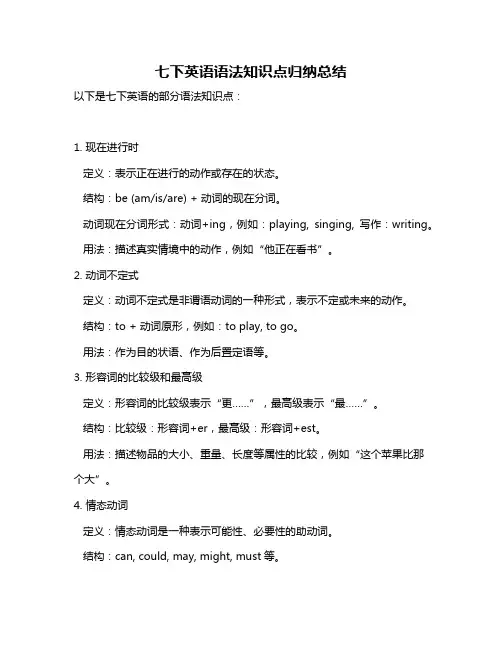
七下英语语法知识点归纳总结以下是七下英语的部分语法知识点:1. 现在进行时定义:表示正在进行的动作或存在的状态。
结构:be (am/is/are) + 动词的现在分词。
动词现在分词形式:动词+ing,例如:playing, singing, 写作:writing。
用法:描述真实情境中的动作,例如“他正在看书”。
2. 动词不定式定义:动词不定式是非谓语动词的一种形式,表示不定或未来的动作。
结构:to + 动词原形,例如:to play, to go。
用法:作为目的状语、作为后置定语等。
3. 形容词的比较级和最高级定义:形容词的比较级表示“更……”,最高级表示“最……”。
结构:比较级:形容词+er,最高级:形容词+est。
用法:描述物品的大小、重量、长度等属性的比较,例如“这个苹果比那个大”。
4. 情态动词定义:情态动词是一种表示可能性、必要性的助动词。
结构:can, could, may, might, must等。
用法:表示可能性,例如“他可能在这儿”;表示必要性,例如“你必须快点儿”。
5. 一般将来时定义:表示未来的动作或状态。
结构:will + 动词原形,例如:will go, will be。
用法:描述未来的计划、安排等,例如“明天我将要去公园”。
6. 一般现在时定义:表示现在的动作或状态。
结构:动词原形,第三人称单数形式为动词+s/es。
用法:描述日常习惯、事实等,例如“我每天早上跑步”。
7. 现在完成时定义:表示过去的动作对现在的影响或过去的动作持续到现在。
结构:have/has + 过去分词。
用法:描述已经完成的动作或状态,例如“我已经完成了作业”。
8. 时间介词和连词表示时间的介词:at, on, in;before, after;since等。
表示时间的连词:when, while等。
用法:描述时间关系,例如“我在上学的时候去了北京”。
9. 宾语从句和定语从句宾语从句:放在动词或介词后面的句子,充当宾语。
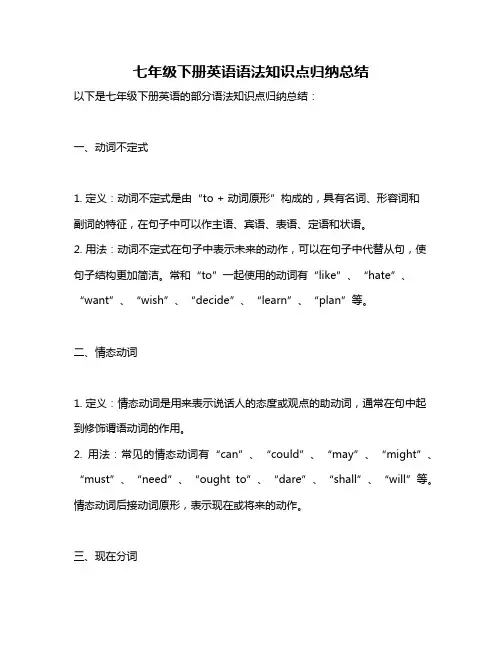
七年级下册英语语法知识点归纳总结以下是七年级下册英语的部分语法知识点归纳总结:一、动词不定式1. 定义:动词不定式是由“to + 动词原形”构成的,具有名词、形容词和副词的特征,在句子中可以作主语、宾语、表语、定语和状语。
2. 用法:动词不定式在句子中表示未来的动作,可以在句子中代替从句,使句子结构更加简洁。
常和“to”一起使用的动词有“like”、“hate”、“want”、“wish”、“decide”、“learn”、“plan”等。
二、情态动词1. 定义:情态动词是用来表示说话人的态度或观点的助动词,通常在句中起到修饰谓语动词的作用。
2. 用法:常见的情态动词有“can”、“could”、“may”、“might”、“must”、“need”、“ought to”、“dare”、“shall”、“will”等。
情态动词后接动词原形,表示现在或将来的动作。
三、现在分词1. 定义:现在分词是动词的一种形式,具有形容词的特征,可以表示正在进行的动作或状态。
2. 用法:现在分词可以作定语、表语和状语。
常和“-ing”一起使用的动词有“seeing”、“feeling”、“thinking”、“doing”、“being”等。
四、介词短语1. 定义:介词短语是由介词和名词或代词构成的短语,用来表示时间、地点、方式等。
2. 用法:介词短语在句子中可以作状语、定语和表语。
常见的介词有“in”、“on”、“at”、“for”、“with”、“by”等。
五、连词1. 定义:连词是用来连接两个句子或从句的词语,表示它们之间的关系。
2. 用法:常见的连词有“and”、“but”、“or”、“so”、“because”、“if”等。
连词在句子中起到承上启下的作用,使句子的意思更加清晰。
以上是七年级下册英语的部分语法知识点归纳总结,希望对你有所帮助。
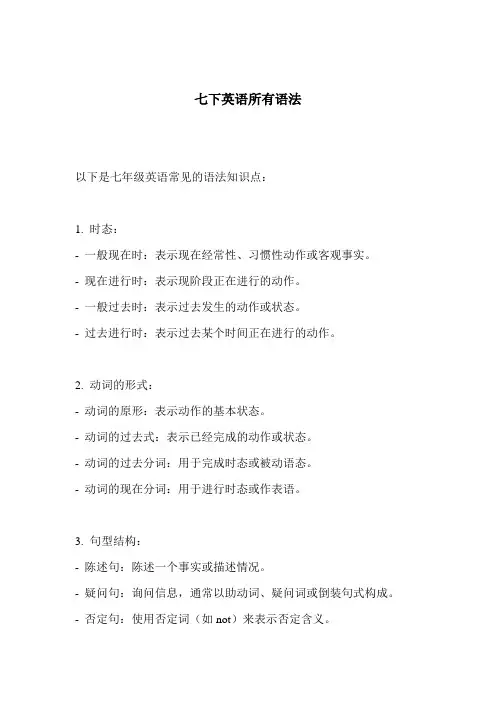
七下英语所有语法
以下是七年级英语常见的语法知识点:
1. 时态:
- 一般现在时:表示现在经常性、习惯性动作或客观事实。
- 现在进行时:表示现阶段正在进行的动作。
- 一般过去时:表示过去发生的动作或状态。
- 过去进行时:表示过去某个时间正在进行的动作。
2. 动词的形式:
- 动词的原形:表示动作的基本状态。
- 动词的过去式:表示已经完成的动作或状态。
- 动词的过去分词:用于完成时态或被动语态。
- 动词的现在分词:用于进行时态或作表语。
3. 句型结构:
- 陈述句:陈述一个事实或描述情况。
- 疑问句:询问信息,通常以助动词、疑问词或倒装句式构成。
- 否定句:使用否定词(如not)来表示否定含义。
4. 代词:
- 主格代词:做主语或动作的执行者。
- 宾格代词:做动词的直接对象或介词的宾语。
- 形容词性物主代词:表示所有关系。
- 名词性物主代词:作为名词的替代词。
5. 介词:
- 表示时间、地点、方式、原因等关系词。
- 用于连接名词、代词或动词不定式。
6. 比较级和最高级:
- 用于比较两个或多个人或事物。
- 比较级通常在形容词或副词前加更、-er或辅音字母+y变i+er。
- 最高级通常在形容词或副词前加most、-est或改变拼写方式。
这仅仅是七年级英语语法的一些例子,具体内容可能还涉及其他知识点。
对于更详细和全面的内容,请参考您所使用的教材或咨询您的英语老师。
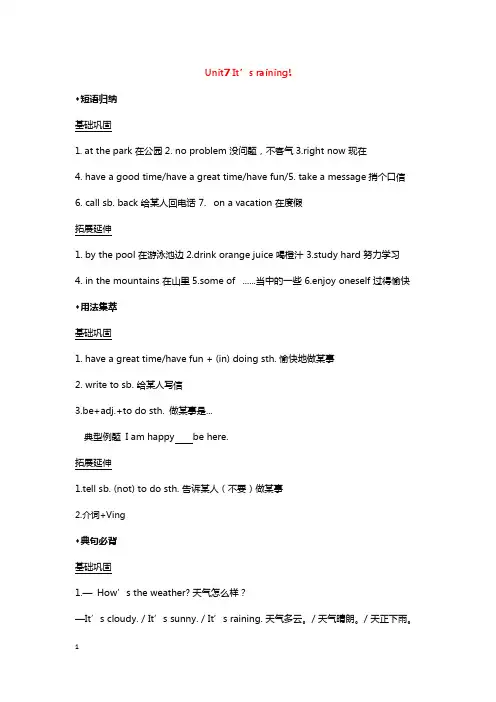
Unit7 It’s raining!◆短语归纳基础巩固1.at the park 在公园2. no problem 没问题,不客气3.right now 现在4.have a good time/have a great time/have fun/5. take a message捎个口信6. call sb. back 给某人回电话7. on a vacation 在度假拓展延伸1.by the pool 在游泳池边2.drink orange juice 喝橙汁3.study hard 努力学习4. in the mountains 在山里5.some of ......当中的一些6.enjoy oneself 过得愉快◆用法集萃基础巩固1.have a great time/have fun + (in) doing sth. 愉快地做某事2. write to sb. 给某人写信3.be+adj.+to do sth. 做某事是...典型例题I am happy be here.拓展延伸1.tell sb. (not) to do sth. 告诉某人(不要)做某事2.介词+Ving◆典句必背基础巩固1.—How’s the weather? 天气怎么样?—It’s cloudy. / It’s sunny. / It’s raining. 天气多云。
/ 天气晴朗。
/ 天正下雨。
2. How’s it going? 情况怎么样?Great! /Not bad./Terrible! 好极了!/ 不错。
/糟糕!3. Can I take a message for him? 我给他捎个口信好吗?4. I’m having a great time visiting my aunt in Canada.我正在加拿大愉快地拜访我的姑姑。
拓展延伸1. My family and I are on a vacation in the mountains.我和我的家人正在山里度假。
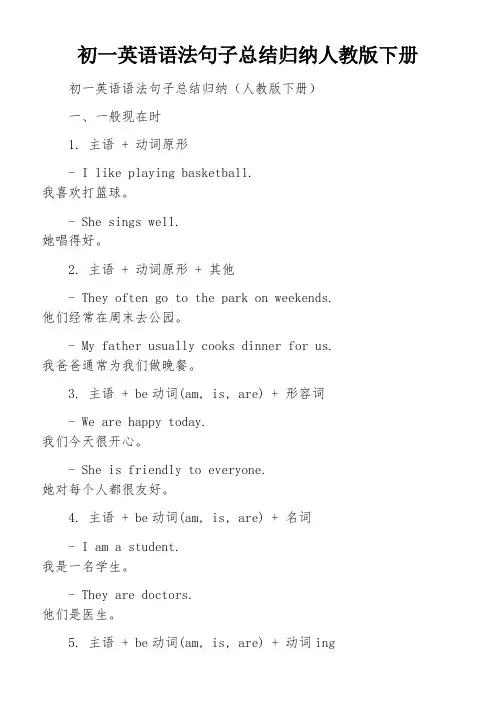
初一英语语法句子总结归纳人教版下册初一英语语法句子总结归纳(人教版下册)一、一般现在时1. 主语 + 动词原形- I like playing basketball.我喜欢打篮球。
- She sings well.她唱得好。
2. 主语 + 动词原形 + 其他- They often go to the park on weekends.他们经常在周末去公园。
- My father usually cooks dinner for us.我爸爸通常为我们做晚餐。
3. 主语 + be动词(am, is, are) + 形容词- We are happy today.我们今天很开心。
- She is friendly to everyone.她对每个人都很友好。
4. 主语 + be动词(am, is, are) + 名词- I am a student.我是一名学生。
- They are doctors.他们是医生。
5. 主语 + be动词(am, is, are) + 动词ing- He is playing football in the park.他正在公园里踢足球。
- We are watching a movie at home.我们正在家里看电影。
二、一般过去时1. 主语 + 动词过去式- I listened to music yesterday.昨天我听音乐。
- She played chess with her friends last night.昨晚她和朋友下棋。
2. 主语 + be动词(was, were) + 形容词- He was tired after school.放学后他感到累。
- They were happy at the party.派对上他们很快乐。
3. 主语 + be动词(was, were) + 名词- I was a student two years ago.两年前我是一名学生。
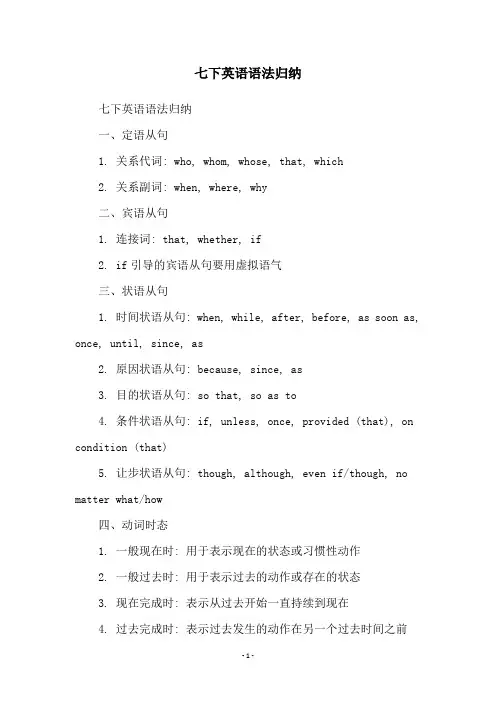
七下英语语法归纳
七下英语语法归纳
一、定语从句
1. 关系代词: who, whom, whose, that, which
2. 关系副词: when, where, why
二、宾语从句
1. 连接词: that, whether, if
2. if引导的宾语从句要用虚拟语气
三、状语从句
1. 时间状语从句: when, while, after, before, as soon as, once, until, since, as
2. 原因状语从句: because, since, as
3. 目的状语从句: so that, so as to
4. 条件状语从句: if, unless, once, provided (that), on condition (that)
5. 让步状语从句: though, although, even if/though, no matter what/how
四、动词时态
1. 一般现在时: 用于表示现在的状态或习惯性动作
2. 一般过去时: 用于表示过去的动作或存在的状态
3. 现在完成时: 表示从过去开始一直持续到现在
4. 过去完成时: 表示过去发生的动作在另一个过去时间之前
5. 现在进行时: 表示动作正在进行
6. 将来时: 表示将来发生的动作
7. 一般将来时: 表示将来会发生的动作或状态
8. 祈使句: 表示下达命令或表达愿望。
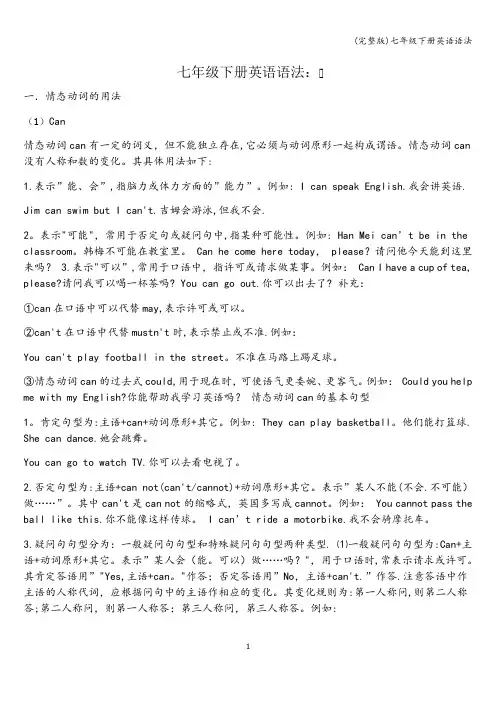
七年级下册英语语法:一.情态动词的用法(1)Can情态动词can有一定的词义,但不能独立存在,它必须与动词原形一起构成谓语。
情态动词can 没有人称和数的变化。
其具体用法如下:1.表示”能、会”,指脑力或体力方面的”能力”。
例如: I can speak English.我会讲英语.Jim can swim but I can't.吉姆会游泳,但我不会.2。
表示"可能",常用于否定句或疑问句中,指某种可能性。
例如: Han Mei can’t be in the classroom。
韩梅不可能在教室里。
Can he come here today, please?请问他今天能到这里来吗? 3.表示"可以”,常用于口语中,指许可或请求做某事。
例如: Can I have a cup of tea, please?请问我可以喝一杯茶吗? You can go out.你可以出去了? 补充:①can在口语中可以代替may,表示许可或可以。
②can't在口语中代替mustn't时,表示禁止或不准.例如:You can't play football in the street。
不准在马路上踢足球。
③情态动词can的过去式could,用于现在时,可使语气更委婉、更客气。
例如: Could you help me with my English?你能帮助我学习英语吗? 情态动词can的基本句型1。
肯定句型为:主语+can+动词原形+其它。
例如: They can play basketball。
他们能打篮球. She can dance.她会跳舞。
You can go to watch TV.你可以去看电视了。
2.否定句型为:主语+can not(can't/cannot)+动词原形+其它。
表示”某人不能(不会.不可能)做……”。
其中can't是can not的缩略式,英国多写成cannot。
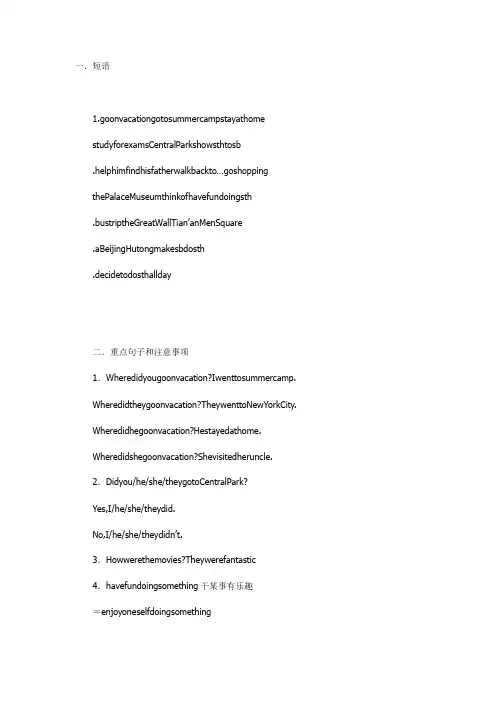
一.短语1.goonvacationgotosummercampstayathomestudyforexamsCentralParkshowsthtosb.helphimfindhisfatherwalkbackto…goshoppingthePalaceMuseumthinkofhavefundoingsth.bustriptheGreatWallTian’anMenSquare.aBeijingHutongmakesbdosth.decidetodosthallday二.重点句子和注意事项1.Wheredidyougoonvacation?Iwenttosummercamp.Wheredidtheygoonvacation?TheywenttoNewYorkCity.Wheredidhegoonvacation?Hestayedathome.Wheredidshegoonvacation?Shevisitedheruncle.2.Didyou/he/she/theygotoCentralPark?Yes,I/he/she/theydid.No,I/he/she/theydidn’t.3.Howwerethemovies?Theywerefantastic4.havefundoingsomething干某事有乐趣=enjoyoneselfdoingsomethingWehavefunlearningandspeakingEnglish. WeenjoyourselveslearningandspeakingEnglish.我们学英语有很多乐趣.5.findsb.doingsth.发现某人在干某事findsb.dosth.发现某人干过某事Ifindhimreadingthenovel(小说).Ifoundhimgointotheroom.6.corner角落,角,拐角处inthecorner在角落里(指在建筑物里面)atthecorner在拐角处(指在建筑物外面或道路的拐角)Mybikeisatthecorner.7.belost迷路了=getlost,lost(adj.) Thegirlwaslostinthebigcity.8.helpsb.(to)dosth.=helpsbforsth帮助某人干某事HealwayshelpsuslearnEnglish9.makesb.dosth.让/使某人干某事let/havesb.dosth.do前不带to Themoviemakesmerelaxing. Lettheboydohishomeworkalone.10.feel+adj.感到...Ifeelhungry/tired/happy/excited11.decidetodosth.决定干某事TheydecidedtogotoHainanonvacation.Uint11Whatdoyouthinkofgameshows?一.词组1..TVshows(电视节目)soapoperasitcomacomedyanactionmovieadocumentaryathrillercartoonBeijingOpera AnimalWorldTellitlikeitisLawTodaygameshowCCTVNewsNewsin30MinutesManandNature ChineseCookingAroundChinatalkshowLucky52 SportsnewssportsshowCultureChina 2.writeanarticlefortheschoolmagazine.给学校杂志写一篇文章3.athirteen-year-oldboy.一个十三岁的男孩4.wearcolorfulclothes.穿着颜色鲜艳的衣服5.interviewsb.采访某人infact.实际上6.wearscarves.戴着围巾thinkof想起,考虑到二.重点句型1.Whatdoyouthinkofsoapoperas?Ican'tstandthem.2.Whatdoyouthinkofsportsshows?Idon'tmindthem.3.Whatdoesshethinkof"HilltopHigh"?Shedoesn'tlikeit.4.WhatdoesTonythinkofTommy?Helikeshim.5.WhatdotheythinkofAmanda?Theyloveher.三.重难点解析1.wear(v.动词)"穿,戴,佩"。
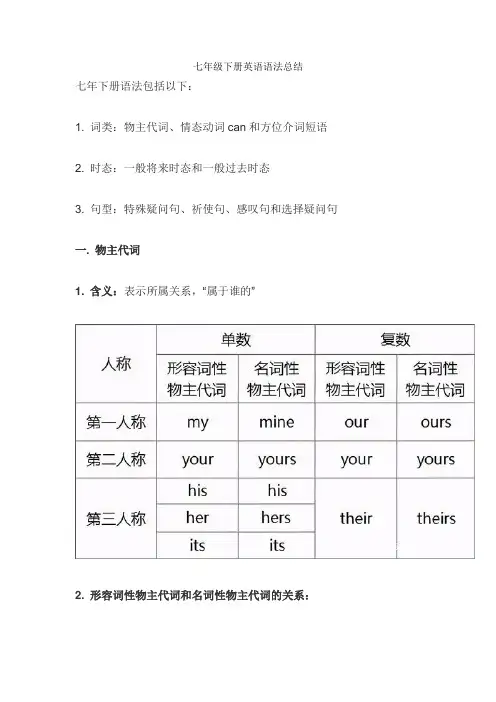
七年级下册英语语法总结七年下册语法包括以下:1. 词类:物主代词、情态动词can和方位介词短语2. 时态:一般将来时态和一般过去时态3. 句型:特殊疑问句、祈使句、感叹句和选择疑问句一. 物主代词1. 含义:表示所属关系,“属于谁的”2. 形容词性物主代词和名词性物主代词的关系:(1)形容词性物主代词:其后必须接名词。
my father, your teacher ...(2)名词性物主代词:相当于与之相对应的形容词性物主代词+名词。
If you can't find your hat, take mine (my hat).二. 情态动词can1. 含义:表达人或物的能力,“能,会”2. 特点:情态动词can没有人称和数的变化,之后要加动词原形。
3. 否定形式:cannot (正式用法)=can’t (口语)4. 句型结构:肯定句:主语+can+动词原形+其他.She/They can swim well.否定句:主语+can't/cannot+动词原形+其他.She/They cannot swim well.一般疑问句:情态动词can+主语+动词原形+其他?Can she/they swim well?一般疑问句答语:Yes,+主语+情态动词can.或No,+主语+can't/cannot.Yes, she/they can.No, she/they can’t.特殊疑问句:特殊疑问词+情态动词can+主语+动词原形+其他? Why can she/they swim well?当特殊疑问词是句子的主语时:特殊疑问词+can+动词原形? Who can swim well?三. 介词1. between ... and ... 在两者之间Lingling sits between Tony and Daming.玲玲坐在托尼和大明之间。
2. among 在三者或三者以上之间Miss Li is among lots of students.李老师在许多同学中间。
七年级下册英语全部语法知识点七年级下册英语的全部语法知识点如下:1.一般现在时:表示经常性的或普遍性的动作或状态。
2.一般过去时:表示过去发生的动作或状态。
3.一般将来时:表示将来发生的动作或状态。
4.现在进行时:表示现在进行或暂时的动作。
5.过去进行时:表示过去某个时间正在进行的动作。
6.一般将来进行时:表示将来某个时间进行的动作。
7.现在完成时:表示过去某个时间开始的动作一直持续到现在或刚刚结束。
8.过去完成时:表示过去某个时间之前已经发生的动作。
9.一般将来完成时:表示将来某个时间之前已经完成的动作。
10.疑问句的构成:使用助动词或be动词提问。
11.否定句的构成:在动词前加not或在助动词后加not。
12.肯定句的构成:直接陈述句子的内容。
13.比较级和最高级:用于比较两个或更多事物的形容词和副词。
14.表示数量的词汇:例如:all, most, some, any, few, a few, many, much等。
15.可数名词和不可数名词的用法。
16.单复数形式的变化规则。
17.形容词的用法和位置:用于修饰名词的词汇。
18.物主代词的用法:例如:mine, yours, his, hers, ours, theirs等。
19.反身代词的用法:例如:myself, yourself, himself, herself, ourselves, themselves等。
20.动词不定式的用法:用于表示目的、意图、结果等。
21.情态动词的用法:例如:can, could, may, might, must等。
22.介词的用法:表示位置、时间、原因、目的等。
23.祈使句的用法:用于发出命令、请求等。
24.从句的引导词和用法:例如:because, if, when, where, who等。
25.定语从句和状语从句的用法。
26.非谓语动词的用法:包括动词不定式、动名词和现在分词。
以上就是七年级下册英语的全部语法知识点。
七年级下册英语语法重点归纳集团文件版本号:(M928-T898-M248-WU2669-I2896-DQ586-M1988)七年级下册英语语法重点归纳整理Unit 1 Where’s your pen pal from一.短语:1 .be from = come from 来自于----2. live in 居住在---3. on weekends 在周末4 .write to sb = write a letter to sb 给某人写信;写信给某人5 .in the world 在世界上in China 在中国6.pen pal 笔友14 years old 14岁favorite subject 最喜欢的科目7.the United States 美国the United Kingdom 英国New York 纽约8.speak English 讲英语like and dislike 爱憎9.go to the movies 去看电影play sports 做运动二.重点句式:1 Where’s your pen pal from = Where does your pen palfrom/2 Where does he live3 What language(s) does he speak4 I want a pen pal in China.5 I can speak English and a little French.6 Please write and tell me about yourself.7 Can you write to me soon8 I like going to the movies with my friends and playing sports.Unit 2 Where’s the post office一. Asking ways: (问路)1. Where is (the nearest) …… (最近的)……在哪里2. Can you tell me the way to ……你能告诉我去……的路吗3. How can I get to ……我怎样到达……呢4. Is there …… near here / in the neighborhood 附近有……吗5. Which is the way to ……哪条是去……的路二.Showing the ways: (指路)1. Go straight down / along this street. 沿着这条街一直走。
七年级英语下册全部语法知识点总结Unit 1 Can you play the guitar?1. 情态动词+V原can do= be able to do2. Play+ the+ 乐器+球类,棋类3. join 参加社团、组织、团体4. 4个说的区别:say+内容Speak+语言Talk 谈论talk about sth talk with sb talk to sbTell 告诉,讲述tell sb (not)to do sthTell stories/ jokes5. want= would like +(sb)to do sth6. 4个也的区别:too 肯定句末(前面加逗号)Either否定句末(前面加逗号)Also 行前be 后As well 口语中(前面不加逗号)7. be good at+ V-ing=do well in 擅长于be good for 对…有益(be bad for对…有害)be good to 对…友好(good 可用friendly,nice,kind替换)be good with和…相处好=get>8. 特殊疑问句的构成:疑问词+一般疑问句9. How/ what about+V-ing …怎么样?(表建议)10. 感官动词(look, sound, taste, smell, feel)+adj/ like11. 选择疑问句:回答不能直接用Yes或者No,要从中选择一个回答12. students wanted for school show(wanted表示招募,含有被动意义)13. show sth to sb=show sb sthgive sth to sb=give sb sth14. help sb (to)do sthHelp sb with sthWith sb’s help= with the help of sbHelp>15. be busy doing sth/ be busy with sth16. need to do sth17. be free= have time18. have friends= make friends19. call sb at +电话号码20.on the weekend= on weekends21. English-speaking students 说英语的学生(带有连词符,有形容词性质)22. do kung fu表演功夫Unit 2 What time do you go to school?1. 问时间用what time或者whenAt+钟点at 7 o’clockat noon/ at night(during/ in the day)On+ 具体某天、星期、特指的一天on April 1st on Sunday on a cold winter morning In +年、月、上午、下午、晚上2. 时间读法:顺读法逆读法:分钟≤30用pastfive past eight(8:05)half past eight(8:30)分钟>30用to a quarter to ten(9:45)整点用…o’clock 7 o’clock(7:00)3. 3个穿的区别:wear 表状态,接服装、手套、眼镜、香水等Put>Dress 表动作,接sb/>4. from…to…5. be/ arrive late for6. 频度副词(行前be后)Always usually often sometimesseldom hardly never7. 一段时间前面要用介词forfor half an hour for five minutes8. eat/ have…for breakfast/ lunch/ dinner/ supper9. either…or10. a lot of=lots of11. it is +adj+for sb +to do sth (adj修饰to do sth)It is important for me to learn English.it is +adj+of sb +to do sth (adj修饰sb)It is kind/ friendly/ nice of you to help me.12. 感叹句:How+adj+主谓!How+adj+a/an +n单+主谓!What+ a/an +adj+ n单+主谓!What+ adj+ n复/ 不可数+主谓!Unit 3 How do you get to school?1. 疑问词How 如何(方式)how long 多长(时间)答语常用“(For/ about +)时间段”how far多远(距离)答语常用“(It’s +)数词+miles/ meters/ kilometers”how often多久一次(频率)答语常用“Always/ often/ every day/…”或“次数+时间”等表频率的状语How soon多快,多久以后,常用在将来时中。
初一英语下册重点词语句型语法今天小编要和大家分享的是初一英语下册重点词语句型语法,希望能帮助到大家学习七年级英语,快快学习吧。
七年级下册英语辅导要点汇编Unit 5 Our School Lifetopic1 How do you go to school?一、重点词语:1. wake up 醒来,唤醒 get up 起床2. go to school 去上学 go home 回家3. go dancing / shopping / skating / swimming 去跳舞;购物、滑冰;游泳go doing something 可用于表达去进行某种娱乐休闲活动。
4. 表示交通方式:on foot 步行by boat 坐船 by ship 坐船 by air 乘飞机by plane 乘飞机 by train 坐火车 by subway 搭乘地铁by car 坐小汽车 by bus 坐公共汽车 by bike 骑自行车5. take the subway / bus / car 搭乘地铁;公共汽车;小汽车6. drive a car to work = go to work by car 驾车去上班take a bus to work = go to work by bus 乘公共汽车去上班go to school on foot = walk to school 步行去上学7. ride a bike / horse 骑自行车;骑马8. after school / class 放学以后;下课以后9. play the piano / guitar / violin 弹钢琴;吉他;小提琴play basketball / soccer / football 打篮球;踢足球;打橄榄球play computer games 玩电脑游戏play with a computer 玩电脑play sports 做运动10. next to 紧挨着,在…旁边11. a plan of my school 一幅我们学校的平面图12. on weekdays 在工作日at weekends 在周末13. have breakfast / lunch / supper / dinner / meals 吃早餐;中餐;晚餐;正餐;一日三餐have classes / lessons / a meeting 上课;上课;开会14. watch TV / movies / games / the animals 看电视;电影;比赛;动物read novels / newspapers / books 看小说;报纸;书15. wash one’s face / clothes 洗脸;衣服16. 反义词:up – down, early – late 近义词:quickly – fastget up early 早起 be late for 迟到17. the first / second / third / fourth day 第一;二;三;四天18. clean the house 打扫房子19. 表示建筑物(尤其学校建筑物):on the playground 在操场at school / home / table 在学校;家里;桌旁in a computer room / tea chers’ office / classroom building / gym / library / lab / canteen在电脑室;教师办公室;教学楼;体操馆;图书馆;实验室;食堂20. around six o’clock = at about six o’clock 大约在六点21. 频率副词:never, seldom, sometimes, often, usually, always二、重点句型:1. It’s time to get up. 该起床的时候了。
初一下册英语重点语法句型以下是初一下册英语的一些重点语法句型:1. 现在进行时:表示现在正在进行的动作或状态,结构为“be动词+现在分词”,例如:He is reading a book now.2. 一般现在时:表示经常性、习惯性的动作或状态,结构为“动词原形+主语+其他”,例如:I go to school every day.3. 一般过去时:表示过去发生的动作或状态,结构为“动词过去式+主语+其他”,例如:They went to the park yesterday.4. 现在完成时:表示过去发生的动作对现在造成的影响或结果,结构为“have/has+动词过去分词+主语+其他”,例如:He has finished 在过去的两年里,这个公司取得了很大的进展。
5. 反义疑问句:表示对陈述的事实进行反问,结构为“陈述部分+疑问部分”,例如:The movie was good, wasn对不对?6. 祈使句:表示请求、命令、建议等语气,以动词原形开头,例如:Please open the window and let in some fresh air.7. 感叹句:表示强烈的感情,结构为“what+名词短语+主语+谓语”或“how+形容词/副词+主语+谓语”,例如:What a beautiful day it is!/How beautifully she singsing!8. 一般将来时:表示将来要发生的动作或状态,结构为“will/would+动词原形”,例如:I will meet my friend tomorrow.9. 宾语从句:表示用一个从句作动词或介词的宾语,例如:I don Theearth is round square的。
10. 状语从句:表示用一个从句作句子的状语,例如:After he finished I finished finished his work, I will go out for a walk.这些语法句型是初中英语学习的重点,需要学生熟练掌握并运用在听说读写各个方面,以便更好地理解和运用英语。
七下英语全书全部语法知识点总结Unit 1 Can you play the guitar?1. 情态动词+V原 can do= be able to do2. Play+ the+ 乐器+球类,棋类3. join 参加社团、组织、团体4. 4个说的区别:say+内容Speak+语言Talk 谈论 talk about sth talk with sb talk to sbTell 告诉,讲述 tell sb (not)to do sthTell stories/ jokes5. want= would like +(sb)to do sth6. 4个也的区别:too 肯定句末(前面加逗号)Either否定句末(前面加逗号)Also 行前be 后As well 口语中(前面不加逗号)7. be good at+ V-ing=do well in 擅长于be good for 对…有益(be bad for对…有害)be good to 对…友好(good 可用friendly,nice,kind替换)be good with和…相处好=get>8. 特殊疑问句的构成:疑问词+一般疑问句9. How/ what about+V-ing …怎么样?(表建议)10. 感官动词(look, sound, taste, smell, feel)+adj/ like11. 选择疑问句:回答不能直接用Yes或者No,要从中选择一个回答12. students wanted for school show(wanted表示招募,含有被动意义)13. show sth to sb=show sb sthgive sth to sb=give sb sth14. help sb (to)do sthHelp sb with sthWith sb’s help= with the help of sbHelp>15. be busy doing sth/ be busy with sth16. need to do sth17. be free= have time18. have friends= make friends19. call sb at +电话号码20.on the weekend= on weekends21. English-speaking students 说英语的学生(带有连词符,有形容词性质)22. do kung fu表演功夫Unit 2 What time do you go to school?1. 问时间用what time或者whenAt+钟点 at 7 o’clockat noon/ at night(during/ in the day)On+ 具体某天、星期、特指的一天on April 1st on Sunday on a cold winter morningIn +年、月、上午、下午、晚上2. 时间读法:顺读法逆读法:分钟≤30用pastfive past eight(8:05) half past eight(8:30)分钟>30用to a quarter to ten(9:45)整点用…o’clock 7 o’clock(7:00)3. 3个穿的区别:wear 表状态,接服装、手套、眼镜、香水等Put>Dress 表动作,接sb/>4. from…to…5. be/ arrive late for6. 频度副词(行前be后)Always usually often sometimesseldom hardly never7. 一段时间前面要用介词forfor half an hour for five minutes8. eat/ have… for breakfast/ lunch/ dinner/ supper9. either…or10. a lot of=lots of11. it is +adj+for sb +to do sth (adj修饰to do sth)It is important for me to learn English.it is +adj+of sb +to do sth (adj修饰sb)It is kind/ friendly/ nice of you to help me.12. 感叹句:How+adj+主谓!How+adj+a/an +n单+主谓!What+ a/an +adj+ n单+主谓!What+ adj+ n复/ 不可数+主谓!Unit 3 How do you get to school?1. 疑问词How 如何(方式)how long 多长(时间)答语常用“(For/ about +)时间段”how far多远(距离)答语常用“(It’s +)数词 +miles/ meters/ kilometers”how often多久一次(频率)答语常用“Always/ often/ every day/…”或“次数+时间”等表频率的状语How soon多快,多久以后,常用在将来时中。
一.短语1.goonvacationgotosummercampstayathomestudyforexamsCentralParkshowsthtosb.helphimfindhisfatherwalkbackto…goshoppingthePalaceMuseumthinkofhavefundoingsth.bustriptheGreatWallTian’anMenSquare.aBeijingHutongmakesbdosth.decidetodosthallday二.重点句子和注意事项1.Wheredidyougoonvacation?Iwenttosummercamp.Wheredidtheygoonvacation?TheywenttoNewYorkCity.Wheredidhegoonvacation?Hestayedathome.Wheredidshegoonvacation?Shevisitedheruncle.2.Didyou/he/she/theygotoCentralPark?Yes,I/he/she/theydid.No,I/he/she/theydidn’t.3.Howwerethemovies?Theywerefantastic4.havefundoingsomething干某事有乐趣=enjoyoneselfdoingsomethingWehavefunlearningandspeakingEnglish. WeenjoyourselveslearningandspeakingEnglish.我们学英语有很多乐趣.5.findsb.doingsth.发现某人在干某事findsb.dosth.发现某人干过某事Ifindhimreadingthenovel(小说).Ifoundhimgointotheroom.6.corner角落,角,拐角处inthecorner在角落里(指在建筑物里面)atthecorner在拐角处(指在建筑物外面或道路的拐角)Mybikeisatthecorner.7.belost迷路了=getlost,lost(adj.) Thegirlwaslostinthebigcity.8.helpsb.(to)dosth.=helpsbforsth帮助某人干某事HealwayshelpsuslearnEnglish9.makesb.dosth.让/使某人干某事let/havesb.dosth.do前不带to Themoviemakesmerelaxing. Lettheboydohishomeworkalone.10.feel+adj.感到...Ifeelhungry/tired/happy/excited11.decidetodosth.决定干某事TheydecidedtogotoHainanonvacation.Uint11Whatdoyouthinkofgameshows?一.词组1..TVshows(电视节目)soapoperasitcomacomedyanactionmovieadocumentaryathrillercartoonBeijingOpera AnimalWorldTellitlikeitisLawTodaygameshowCCTVNewsNewsin30MinutesManandNature ChineseCookingAroundChinatalkshowLucky52 SportsnewssportsshowCultureChina 2.writeanarticlefortheschoolmagazine.给学校杂志写一篇文章3.athirteen-year-oldboy.一个十三岁的男孩4.wearcolorfulclothes.穿着颜色鲜艳的衣服5.interviewsb.采访某人infact.实际上6.wearscarves.戴着围巾thinkof想起,考虑到二.重点句型1.Whatdoyouthinkofsoapoperas?Ican'tstandthem.2.Whatdoyouthinkofsportsshows?Idon'tmindthem.3.Whatdoesshethinkof"HilltopHigh"?Shedoesn'tlikeit.4.WhatdoesTonythinkofTommy?Helikeshim.5.WhatdotheythinkofAmanda?Theyloveher.三.重难点解析1.wear(v.动词)"穿,戴,佩"。
根据不同宾语,翻译不同的汉语意思。
wearearrings戴耳环wearadress穿连衣裙wearawatch戴手表wearabeard蓄胡子wearlonghair留长发2.think"想,考虑,思索"(v.动词)可以和许多介词搭配,组成新的意思。
A:thinkof"考虑";"有...的看法",有时等于thinkabout. WhatdoeshethinkofBeijingOpera?他对京剧有什么看法?Mymotheralwaysthinksofeverything!我妈妈总是想到所有的东西。
thinkhighlyofsb./sth.对某人或某物评价甚高MrBlackthinkshighlyofhisson.布莱克先生对他儿子评价甚高。
B:thinkabout"考虑"(指计划,观念,看它是否相宜、可行)HeisthinkingaboutgoingtoChina.他正在考虑去中国。
3.too与either的区别too"也",表示肯定意义,与肯定的表达方法连用;而either"也不",表示否定意义,与否定的表达方法连用。
(1)—Mybrotherlikestoplaysoccer.我哥哥喜欢踢足球。
—Ido,too.我也是(喜欢)。
(2)—Mybrotherdoesn'tliketoplaysoccer.我哥哥不喜欢踢足球。
—Idon't,either.我也不喜欢。
also也可以表示"也",但一般情况下,too和either放在句子之后,also放在动词之前。
Wealsolovetalkshows.我们也喜欢访谈节目。
4.athirteen-year-oldboy一个十三岁的男孩此结构中,year用单数形式,且用连字符,这种结构用作定语。
afive-month-oldbaby一个五个月大的婴儿5.enjoy(v.喜爱,享受)enjoy后面接名词、代词或动名词,注意与like/love用法的区别。
like/love还可以接动词不定式(todo)。
Ienjoythesoapoperas.我喜爱肥皂剧。
Ienjoywatchingthesoapoperas.我喜爱看肥皂剧。
但我们不能说:Ienjoytowatchthesoapoperas.只能说:Ilike/lovetowatchthesoapoperas.6.mind表示"介意,反对"的意思时,通常用在疑问句、否定句中。
Wouldyoumindopeningthewindow?请你打开窗子好不好?Hedoesn'tmindthecoldweatheratall.他一点都不在乎寒冷的天气。
多用于以下句型:(表示请求或征求意见)后接动名词/名词/代词。
Wouldyoumind(doing)...?Doyoumind(doing)...?7.stand表示忍受(多用于否定句、疑问句)Hecan'tstandthehotweather.他忍受不了炎热的天气。
Canyoustandthepain?你忍受得了疼吗?9.Whatdoyouthinkof...?你认为...怎么样?(谈论对某事物的喜好程度)可选择的回答有:(1)Ilikeit.(2)Idon'tmindit.(3)Idon'tlikeit.(4)Ican'tstandit.(5)Ilikeitverymuch.(6)Iloveit.(7)It'sbeautiful.(8)They'refantasticUnit12Don'teatinclass.一.短语.1.inclass在课上2.onschoolnights在上学的晚上3.schoolrules校规4.notalking禁止交谈5.listentomusic听音乐6.haveto不得不7.takemydogforawalk带狗去散步8.eatoutside在外面吃饭9.inthehallway在走廊上10.wearauniform穿制服11.arrivelateforclass上学迟到12.afterschool放学后17.beinbed在床上13.practicetheguitar练习弹吉它14.inthecafeteria在自助食堂里15.meetmyfriends和我朋友见面16.byteno'clock.十点之前18.theChildren'sPalace少年宫19.helpmymommakedinner帮助我妈做饭二.重点句型1.Don’tarrivelateforschool=Don’tbelateforschool2.Don’tfight=3.Don’tlistentomusicintheclassroom.4.Don’tru ninthehallways5.Don’tsmoke.It’sbadforyourhealth.6.Don’tplaycardsinschool7.Don’ttalkinclass8.Don’twatchTVonschoolnights.9.Don’tsleepinclass.10.Don’tplaysportsintheclassrooms.11.Don’tsingsongsatnight.12.Don’ttalkwhenyoueat.13.Don’twearhatsinclass.14.Dohomeworkby10:00.15.Cleanyourhouse!16.Makethebed.17.Canwe……?Yes,wecan.No,wecan’t.Eg:Canwearrivelateforclass?No,wecan’t.Wecan’tarrivelateforclass.18.Doyouhavetowashyourclothes?Yes,Ido./No,Idon’t.三.重难点解析:1.情态动词haveto的用法,意思是"必须、不得不",它侧重于客观上的必要和外界的权威。